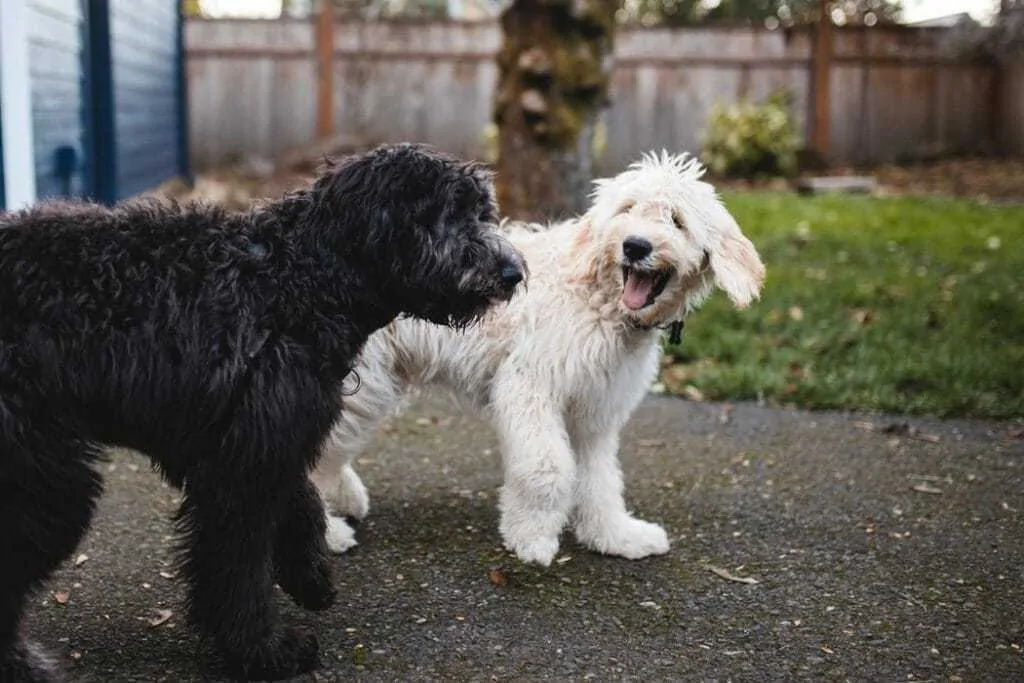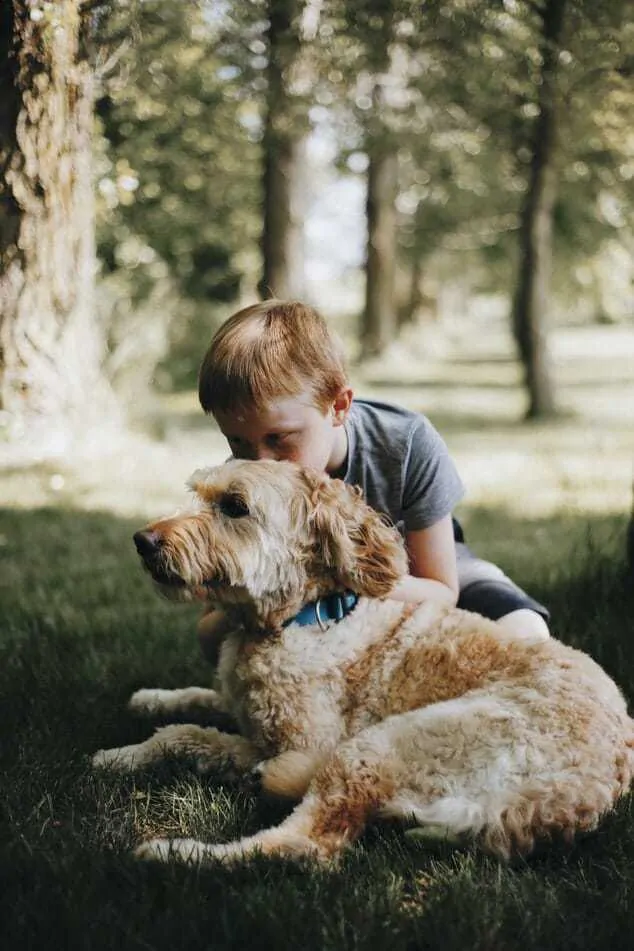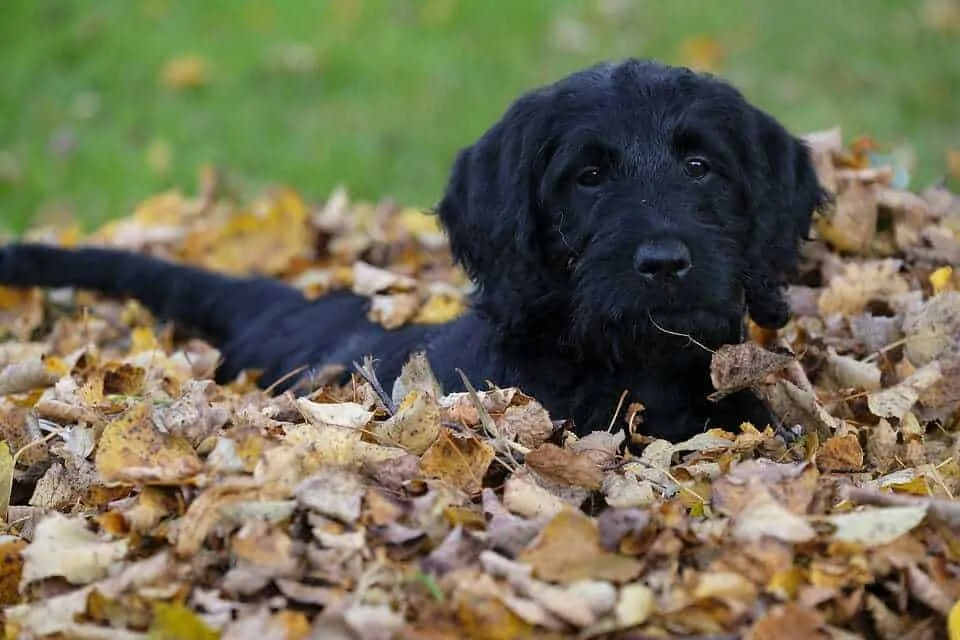Unless you’ve been living under a rock or somewhere on Mars, chances are you’ve heard of the Labradoodle. It seems that everyone has an opinion about this fast rising star in the canine kingdom.
Dog people, cat people, and just regular people have been spreading their thoughts and debating over the famous Labradoodle and whether or not he lives up to all the hype.
But what is it about this fascinating dog breed that has so many people talking? Well, for starters, part of it has to do with the fact that the Labradoodle isn’t a breed at all!
So, just what is the Labradoodle, where did he come from, why is he so popular, and is this the right dog for you?
Today, we hope to answer all of your questions with an honest and thorough assessment of everything Labradoodle. From his lifespan, to health issues, to Labraoodle temperament and more, this is your ultimate Labradoodle dog breed information guide!
Ready to learn? Great. Let’s get started!
Contents
1. What Is A Labradoodle?
A Labradoodle is a cross between the Labrador Retriever and the Standard Poodle
Just because you’ve heard of the Labradoodle doesn’t mean you know exactly what he is, and that’s okay.
Over the past decade or so, the Labradoodle has risen quickly in popularity amongst dog lovers and breeders alike, but in spite of his fame, some novice Labradoodle enthusiasts don’t realize that the Labradoodle is actually not a purebred dog.
So then, what is the Labradoodle, you ask?
The Labradoodle is a crossbreed between two of some of the canine world’s most popular parent breeds – a Labrador Retriever and a Standard Poodle.
Also known as a hybrid or a designer dog, the Labradoodle is one of a number of doodle superstars rising to fame.
Doodle dogs like Goldendoodles, Shepadoodles, Cavoodle, Schnoodle, and many more Poodle mixes are taking the world by storm and stealing the hearts of dog lovers everywhere.
But there is something that makes the Labradoodle a little special. He is, in fact, one of the pioneers of the doodle-verse world and has in a sense paved the way for other doodle hybrids to come along behind him.
Keep reading to learn more.
2. How Did The Labradoodle Come To Be?
Did you know the first Labradoodle litter was born in Australia?
The Labradoodle of today is one of America’s most favorite family dogs, but like many of his canine counterparts, the Labradoodle was originally created for working purposes.
It was in Australia in 1989 when a guide dog trainer by the name of Wally Conron came across a woman whose husband was blind and needed the assistance of a seeing eye dog. The only problem? The woman’s husband suffered seriously from dog allergies.
Wally Conron worked with Labradors and Golden Retrievers, and while these two breeds are famous for their intelligence and knack for servitude, they are also known to shed heavily.
In an effort to help this family in need, Mr. Conron went to work with Standard Poodles in hopes that he would find one with the necessary traits to be trained as a guide dog. Unfortunately, no Poodle he came across passed the test.
Eventually, and under the pressures of his boss, Mr. Conron turned to crossbreeding. He bred one of his Labradors with a Standard Poodle, and shortly thereafter a litter of hybrid puppies was born.
Out of the litter, only one puppy was able to be successfully considered hypoallergenic. Best of all, that hypoallergenic puppy also had the necessary traits to be trained as a guide dog.
Wally and his team began working and perfecting the Lab and Poodle mixes right away, however, they did hit a roadblock with clients who were wary of taking service dogs that weren’t purebred. Wally’s solution? He called up the media with fabulous news about this wonderful new dog breed he had created. And alas, the Labradoodle exploded onto the scene!
Once the Labradoodle began being seen as his own breed, he was quickly accepted by those in need of hypoallergenic dog breeds, socialization homes, and dog training facilities near and far.
Three decades have passed since then and although the fame of the Labradoodle simmered for a bit, his name is back in the spotlight as of late for being one of the United States most popular companion pets.
Of course, as we learn more about our canine counterparts, many of us now realize that just because someone says they have created a new dog breed doesn’t really mean they have created a purebred.
In fact, and even though thirty years have come and gone, most Kennel Clubs still don’t recognize the Labradoodle as a purebred and instead see him as a crossbreed.
Does this matter? Actually, when breed standard, temperament, health, and appearance come into play when comparing purebreds and crossbreeds, it does.
Let’s talk more about the crossbreed controversy.
3. What You Should Know About The Crossbreed Controversy
Crossbreeds and purebreds have been going head to head for a while when it comes to which is healthier.
The practice of crossbreeding is by no means a new one. In fact, it has been going on for centuries now, practically as long as dogs and humans have coexisted.
Humans are notorious for crossbreeding dogs in the hopes of perfecting certain genetic traits for different purposes.
In fact, the truth is that most purebred dogs we know and love today are the result of centuries of careful crossbreeding to ensure the right personality traits and physical traits survive through generations.
Of course, that’s not always a good thing. Many experts argue that because of generations of overbreeding, many purebreds are actually now more unhealthy than they’ve ever been, with higher instances of disease and birth defects as a result of inbreeding to hold onto certain genetic traits.
So does that mean that crossbreeds are healthier than purebreds?
Well, those who support crossbreeding certainly think so. In fact, some insist that the practice of crossbreed may lead to healthier puppies because it widens the genepool and therefore reduces the chances of dogs getting genetic diseases.
However, this has yet to be proven.
Health is not the only argument to be had between those who support crossbreeding and those who don’t. Those who disagree with the breeding and selling of crossbreeds claim that, along with being genetically unpredictable, crossbreeds are also nothing more than mutts.
Others say that crossbreeds are different than mutts because, while mutts may have a number of different breeds in their bloodline, crossbreeds are the offspring of two specifically chosen purebred parent breeds.
So, who is right and who is wrong? No one knows for certain and neither do we. What we do know is that the Labradoodle continues to be one of the most popular dogs regardless of the fact that he is a crossbreed, and with his winning look, temperament, and intelligence, it’s easy to see why.
After all, he is a mix of some of the world’s most popular and intelligent dog breeds. So, how do you get to know a Labradoodle a little better?
To understand what makes a Labradoodle a Labradoodle, let’s take a better look at his parent breeds, starting with Labrador Retriever.
4. A Brief Overview Of The Labrador Retriever
The Labrador Retriever is America’s favorite dog breed and has long been a favorite service and therapy dog.
Temperament – Affectionate, Outgoing, Intelligent, Friendly
Weight – 55 – 80 Pounds
Lifespan – 10 – 12 Years
Health Concerns – Patellar Luxation, osteochondritis dissecans, canine hip dysplasia, elbow dysplasia, shoulder dysplasia, obesity, ear infections, heart disease, and bloat.
Hypoallergenic – No
Coat Coloring – Black, Chocolate, And Yellow
More About the Labrador Retriever
With his adorable, expressive face, sweet disposition, and intelligent brain, it’s no wonder the Labrador Retriever is America’s most favorite dog breed, according to the American Kennel Club.
Bred originally for water retrieving, the Labrador Retriever hails from Newfoundland, Canada. His thick, double layered coat served as a protection against the cold Canadian waters, where the working Lab would swim to retrieve his fisherman master’s catch of the day.
The modern day Labrador Retriever is a family favorite and is known to do well with children of all ages and even other household pets.
Now let’s take a look at the Standard Poodle!
5. A Brief Overview Of The Standard Poodle
The Standard Poodle is known for his beauty and intelligence.
Temperament – Clever, Athletic, Entertaining, Proud
Weight – 40 – 70 Pounds
Lifespan – 10 – 18 Years
Health Concerns – Hip dysplasia, eye disorders, idiopathic epilepsy, von Willebrand’s disease, sebaceous adenitis, and bloat.
Hypoallergenic – Yes
Coat Coloring – Black, white, blue, black & white, silver, grey, apricot, cream, sable, brown, and red.
More About the Standard Poodle
The Standard Poodle is as smart as he is beautiful. With a long history as a circus performer, street performer, water dog, and even noble ladies’ fashionable sidekick, it’s easy to see why the Standard Poodle is such a popular breed across the globe today.
And while he has long been known as the “French Poodle”, the Standard Poodle actually originally hails from Germany, where he was bred as a duck hunting dog.
Back in his humble working days, the Standard Poodle’s haircut was something of a necessity, with the famous pompons protecting his body from the harsh conditions of the cold water.
Eventually, as the Poodle migrated to France, his fanciful hairdo was seen as somewhat of a fashion statement.
Today, the Poodle ranks in at number 7 out of 194 on the American Kennel Club’s list of America’s most popular dog breeds.
So, a cross between the friendly Labrador and Intelligent Poodle must make something great, right? Let’s talk about the Labradoodle!
6. An Overview Of The Labradoodle
The Labradoodle is a hybrid between the Labrador and the Standard Poodle
Temperament – Affectionate, Outgoing, Energetic, Intelligent
Weight – 50 – 65 Pounds
Lifespan – 12 – 15 Years
Health Concerns – Patellar Luxation, osteochondritis dissecans, canine hip dysplasia, elbow dysplasia, shoulder dysplasia, obesity, ear infections, heart disease, eye disorders, idiopathic epilepsy, von Willebrand’s disease, sebaceous adenitis.
and bloat.
Hypoallergenic – Yes
Coat Coloring – Black, chocolate, golden, red, white, silver, and cream.
More About the Labradoodle
Because the Labradoodle is a cross between two very different purebred parents, aspects like his appearance, temperament, health, and more can be left up to chance.
However, since the older generation Labradoodles have been around for nearly three decades and have gone through a certain process of refining, there may be some potential for some traits to be more predictable than others.
Of course, this depends on your Labradoodle’s genetic history and whether or not he is a first, second, third, or fourth generation Labradoodle.
Let’s take a look at what you can expect when expecting a Labradoodle.
7.What Does The Labradoodle Look Like?
Labradoodles can come in a variety of colors.
Labradoodle Height: 21 – 24 Inches
Labradoodle Weight: 50 – 65 Pounds
Labradoodle Coat Colors: Black, chocolate, golden, red, white, silver, and cream.
Labradoodle Coat Types: Soft, wavey, curly, fleece, wool
Hypoallergenic Coat: Yes
What Does The Labradoodle Look Like?
Determining exactly what your Labradoodle will look like could be a challenge and will be based primarily on genetics, the generation of your Labradoodle, as well as breeding.
Keep in mind that a first generation crossbreed, or a crossbreed that is the direct descendant of a purebred Lab and purebred Poodle, is going to have a less predictable appearance than that of a second, third, or fourth generation crossbreed, who is the descendant of two Labradoodle parents.
However, on average, most Labradoodles are known to have hypoallergenic coats that are soft, curly or wavy, and can come in at least seven different colors.
Labradoodles have floppy ears, long tails, and big, brown eyes. Their faces are expressive and happy, and they have long legs that may appear somewhat lanky during adolescence as they are growing into themselves.
But what about temperament? Will a Labradoodle’s temperament be left up to chance and genetics just like appearance? Keep reading to find out!
8. What Is The Labradoodle’s Temperament?
When properly trained and socialized, the Labradoodle makes for a wonderful family pet.
It’s not always easy to pinpoint the exact temperament of a dog since lifestyle, health, training and socialization all play a role in a dog’s behavior. Still, we can sometimes look into the genetics and behavior of parent breeds to help us get a good idea of what our dogs may behave like based on what they were bred for early on.
In the case of the Labradoodle, who is the offspring of the Labrador Retriever and the Standard Poodle, his overall temperament should be friendly, athletic, and outgoing.
Both the Labrador Retriever and the Poodle are friendly and do well in family settings. Both are intelligent dogs who need lots of mental stimulation as well as physical stimulation to stay happy and well rounded, so you can expect the same from a Labradoodle.
And while the Labradoodle does get along well with other household pets, he may have a high prey drive due to his Poodle DNA, so a good recall should be put into place early on and he should be walked on a leash and harness during training.
Due to his clever brain and athletic nature, the Labradoodle should also be socialized and trained early on and then consistently throughout his lifetime to help keep him from becoming overly anxious, bored, depressed, or destructive.
Puzzle toys, chew toys, crate training, and proper exercise will also play a role in your Labradoodle’s overall happiness and health.
Speaking of health, let’s talk more about the Labradoodle’s potential health issues and lifespan.
9. Labradoodle’s Lifespan And Health Issues
All dogs can be prone to genetic health issues and the Labradoodle is no exception. And while some do argue that crossbreeds are in fact healthier than their purebred counterparts, there has yet to be any real science to back this up.
The truth is that, like all dogs, your Labradoodle should undergo health screening tests to see what his potential health risks he may face in his lifetime.
You should also keep in mind that the Labradoodle can be prone to any genetic health issues of his parent breeds face.
The Labradoodle has a lifespan of 12 – 15 years and, according to many experts, the most common health problems in the Labradoodle dog include:
- Hip Dysplasia
- Elbow Dysplasia
- Bloat
- Progressive Retinal Atrophy
- And Von Willebrand’s disease
Experts also agree that breeding standards can have a big impact on the overall health of any dog, so make sure if you buy your Labradoodle as a puppy that he is coming from a responsible, reputable source.
A high quality diet for your Labradoodle’s age, weight, and activity level will also help ensure he stays happy and healthy as well as routine veterinary visits, and proper grooming and exercise routines.
And since we are on the subject of grooming, let’s talk about how to groom, train, and exercise a Labradoodle dog. Keep reading.
10. Grooming, Training And Exercise Requirements For A Labradoodle
Labradoodles are active and athletic dogs who need lots of exercise.
Grooming your Labradoodle will play a large role in keeping him healthy. Your Labradoodle will need to visit a good groomer regularly if you opt to keep his hair long, and he should be brushed consistently with quality grooming brushes to keep his hair from becoming tangled and matted.
The Labradoodle may also be prone to ear infections so he will need his ears cleaned regularly to keep moisture and waxy buildup at bay.
Last but not least, the Labradoodle will need his nails trimmed on a routine basis to keep them from breaking or splitting during all of his activities and play time.
Training your Labradoodle should be a breeze so long as you use positive reinforcement methods like treats and praise.
The Labradoodle is a sensitive dog who is eager to please and will enjoy learning new tricks and showing them off for you!
Remember, the Labradoodle is very smart and will be eager to please you and learn new things, so teach him fun tricks and give him jobs to do around the house like helping to load the dishwasher, bringing in the newspaper, or sorting the laundry. With training treats and praise, your Labradoodle’s abilities may surprise you!
Exercising your Labradoodle is incredibly important as this is a very high-energy breed who can easily become bored and destructive if not given the proper outlets to burn all that excess energy.
He will need a good hour or so walk or jog every day and plenty of backyard play time. The Labradoodle enjoys games of fetch and tug of war and will love playing with other furry playmates and his human siblings.
So, does the Labradoodle dog sound like a dream come true or a dog you want to stay away from? Keep in mind that, like all dogs, there are pros and cons to owning this amazing crossbreed.
See for yourself below.
11. What Are Some Pros And Cons Of Owning A Labradoodle Dog?
All dogs come with a list of pros and cons.
All dogs come with a list of pros and cons that potential owners should be aware of. The trick is knowing what kind of dog you are committing to and making sure that dog fits into your unique lifestyle.
Not sure if the Labradoodle is right for you? Let’s take a look at some of the pros and cons of owning a Labradoodle dog.
Pros To Owning A Labradoodle:
- They are hypoallergenic
- They are highly intelligent
- Labradoodles are great family dogs
- They get along with just about everyone
- They are easy to train and eager to please
Cons To Owning A Labradoodle:
- Labradoodles are crossbreeds and may have unpredictable health issues, temperaments, and appearances.
- They are highly energetic and require lots of time and patience during training
- They are high maintenance when it comes to grooming and exercise
- They can be prone to destructive behaviors if they get bored
12. What Is The Ideal Home Type For A Labradoodle Dog?
Labradoodle’s are energetic and need lots of space to run and play.
The Labradoodle is an adaptable dog and can do well in apartments if properly trained, exercised, and socialized, but you should keep in mind that this is a high-energy dog who needs plenty of exercise, outside play time, and training.
The best home type for a Labradoodle dog will be a home where the owners are around often and able to offer their Labradoodle plenty of exercise in the form of walks, jogs, and playtime.
As they get older, Labradoodles tend to calm down, but their puppyhood persona could last them up to three years and they will need quite a bit of attention during that time.
Luckily, these dogs do great in homes with active, young families who have the time, patience, and ability to care for this outgoing and intelligent crossbreed.
13. Choosing To Adopt Or Buy – Tips On Finding The Healthiest Labradoodle Dog Or Puppy Possible.
Going through responsible sources to get your Labradoodle puppy or dog could save you money and emotional stress in the long run.
Responsible breeding practices are clearly important when it comes to having a healthy, happy dog, regardless of if you are dealing with a purebred or a crossbreed.
If you plan on getting your Labradoodle as a puppy, avoid online sellers, backyard breeders, and pet stores.
While Labradoodle breeders may be costlier up front, you will likely be saving yourself a great deal of money and emotional distress in the long run by ensuring you are getting the healthiest puppy possible.
This is because responsible breeders will have health screened their Labradoodle puppies before selling them and will be able to offer you certificates of health proving that your puppy is free of any major health concerns before going home with you.
If you would like to adopt instead of buy, that’s great! There are plenty of breed and crossbreed specific rescues around the United States that specialize in Labs, Poodles, and Doodles of all sorts.
Rescuing a Labradoodle dog is going to be less expensive than buying a Labradoodle puppy from a breeder, but of course the best part about rescuing a Labradoodle is that you are able to give a needy dog a good and loving home.
Are you planning on getting a Labradoodle to call your own? Why or why not? Tell us your thoughts in the comments below!

Madison Guthrie (also known as Sonny Mackenzi) is a pet care specialist and positive-reinforcement trainer who works most closely with anxious and reactive dogs. Born and raised in Littleton, Colorado, Madison developed a love for animals at an early age and spent most of her childhood outdoors rescuing stray pets and helping to rehabilitate injured wildlife. Along with animals, Madison also developed a love for writing and music. Over the past five years, she has worked to use her passions to help the pets and pet parents in her community build stronger bonds and live happier, healthier lives together. Currently, Madison lives in South Pasadena, California where she owns and operates Miss Madison LLC, a marketing company that focuses on helping privately owned veterinary establishments and pet care companies grow and thrive. She also works as a dog trainer at My Dog Spot, which is an award-winning pet care and training establishment in Pasadena, California.













